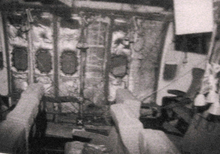| Bojinka plot | |
|---|---|
 Aftermath of the fatal Philippine Airlines Flight 434 bombing | |
| Location | Makati, Philippines (Phase I) Airspace (Phase II) Langley, Virginia, U.S. (Phase III) |
| Date | Planned to be executed January 15–22, 1995; foiled on January 6–7, 1995 |
| Target | Pope John Paul II (Phase I) American airliners (Phase II) CIA Headquarters (Phase III) |
Attack type | Islamic terrorism, suicide attack, bombing and aircraft hijacking |
| Weapons | Improvised explosive device Cessna |
| Deaths | 1 (test bomb in Philippine Airlines Flight 434) |
| Injured | 10 (test bomb in Philippine Airlines Flight 434) |
| Perpetrators | Al-Qaeda and Jemaah Islamiyah |
| Motive | United States foreign policy in the Middle East Anti-Christian sentiment |
| Accused | Khalid Sheikh Mohammed |
| Convicted | Ramzi Yusuf Abdul Hakim Murad Wali Khan Amin Shah |

The Bojinka plot (Arabic: بوجينكا; Tagalog: Proyektong Bojinka) was a large-scale, three-phase terrorist attack planned by Ramzi Yousef and Khalid Sheikh Mohammed for January 1995. They planned to assassinate Pope John Paul II; blow up 11 airliners in flight from Asia to the United States, with the goal of killing approximately 4,000 passengers and shutting down air travel around the world; and crash a plane into the headquarters of the United States Central Intelligence Agency (CIA) in Langley, Virginia.[1][2]
Despite careful planning, the Bojinka plot was disrupted after a chemical fire drew the attention of the Philippine National Police – Western Police District (PNP-WPD, now known as Manila Police District PNP-MPD) on January 6–7, 1995. Yousef and Mohammed were unable to stage any of the three attacks. The only fatality resulted from a test bomb planted by Yousef on Philippine Airlines Flight 434, which killed one person and injured 10 others. They also planted two other bombs in a shopping mall and theater in the southern Philippines. Elements of the Bojinka plot (including the plan to crash a plane into the CIA headquarters) would be used in the September 11 attacks on the World Trade Center and the Pentagon, six years later.
- ^ Mazzetti, Mark (November 14, 2009). "Portrait of 9/11 'Jackal' Emerges as He Awaits Trial". The New York Times. Archived from the original on September 2, 2023. Retrieved November 15, 2009.
- ^ Lumpkin, John J. "Project Bojinka". Global Security. Archived from the original on June 12, 2008. Retrieved November 6, 2010.